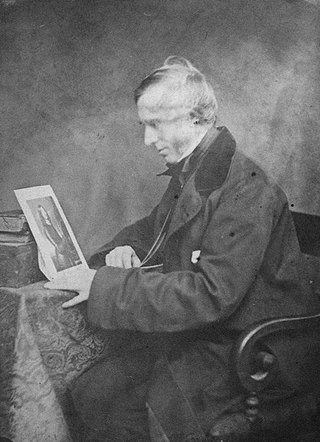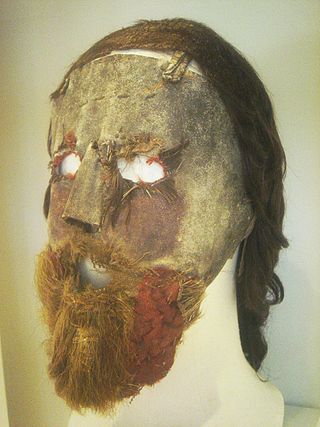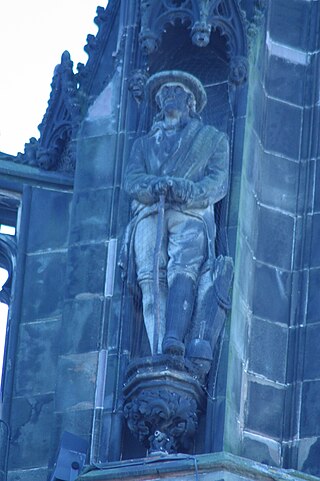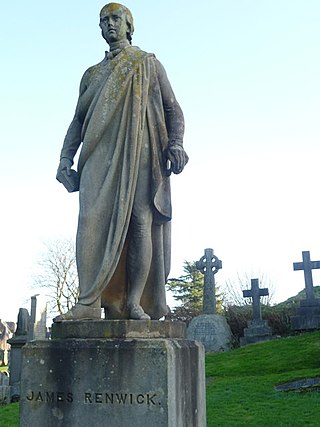
Wigtown is a town and former royal burgh in Wigtownshire, of which it is the county town, within the Dumfries and Galloway region in Scotland. It lies east of Stranraer and south of Newton Stewart. It is known as "Scotland's National Book Town" with a high concentration of second-hand book shops and an annual book festival.

John Michael Welsh of Irongray was a leader of the Scottish Covenanter movement. Dunlop, an early 20th century writer, says: "It is a noteworthy fact that there exists no memoir of John Welsh of Irongray, though from the Battle of Rullion Green till Bothwell Bridge he was the most conspicuous Covenanting minister in Scotland. Had he glorified God in the Grassmarket, or fallen in some scuffle with Claverhouse's dragoons, or even like his friend Blackadder of Troqueer languished in prison on the Bass Rock, some pious hand would have been moved to write his story." Dunlop also wrote: "The events of Welsh's life must be sought for in the pages of Wodrow and Kirkton and in the letters and State papers of the reign of Charles II. After spending a fortnight hunting him in the British Museum, I have come to sympathise with Clavers and his dragoons. Mr John Welsh is a most elusive gentleman."

John Graham, 7th of Claverhouse, 1st Viscount Dundee was a Scottish soldier and nobleman, a Tory and an Episcopalian. He was responsible for policing southwest Scotland during and after the religious unrest and rebellion of the late 17th century, and went on to lead the Jacobite rising of 1689.

Mark Napier was a Scottish lawyer, biographer and historical author. He was called to the Bar, practised as an advocate, and was made Sheriff of Dumfries and Galloway. Napier wrote from a strongly Cavalier and Jacobite standpoint. He published Memoirs of the Napiers, of Montrose, and of Graham of Claverhouse, the last of which gave rise to controversy.

Alexander Peden, also known as "Prophet Peden", was one of the leading figures in the Covenanter movement in Scotland.

Old Mortality is one of the Waverley novels by Walter Scott. Set in south west Scotland, it forms, along with The Black Dwarf, the 1st series of his Tales of My Landlord (1816). The novel deals with the period of the Covenanters, featuring their victory at Loudoun Hill and their defeat at Bothwell Bridge, both in June 1679; a final section is set in 1689 at the time of the royalist defeat at Killiecrankie.

Sir Robert Grierson, 1st Baronet of Lag was a Scottish baronet from Dumfriesshire.

The Killing Time was a period of conflict in Scottish history between the Presbyterian Covenanter movement, based largely in the southwest of the country, and the government forces of Kings Charles II and James VII. The period, roughly from 1679 to the Glorious Revolution of 1688, was subsequently called The Killing Time by Robert Wodrow in his The History of the Sufferings of the Church of Scotland from the Restoration to the Revolution, published in 1721–22. It is an important episode in the martyrology of the Church of Scotland.

James Renwick was a Scottish minister who was the last of the Covenanter martyrs to be executed before the Glorious Revolution.

The Battle of Drumclog was fought on 1 June 1679, between a group of Covenanters and the forces of John Graham of Claverhouse, at Drumclog, in South Lanarkshire, Scotland.

Margaret Wilson was a young Scottish Covenanter from Wigtown in Scotland who was executed by drowning for refusing to swear an oath declaring James VII of Scotland as head of the church. She died along with Margaret McLachlan. The two Margarets were known as the Wigtown Martyrs. Wilson became the more famous of the two because of her youth. As a teenager, her faith unto death became celebrated as part of the martyrology of Presbyterian churches.

John Brown (1627–1685), also known as the Christian Carrier, was a Protestant Covenanter from Priesthill farm, a few miles from Muirkirk in Ayrshire, Scotland. He became a Presbyterian martyr in 1685.

John Nisbet (1627–1685) was a Scottish covenanter who was executed for participating in the insurgency at Bothwell Brig and earlier conflicts and for attending a conventicle. He took an active and prominent part in the struggles, of the Covenanters for civil and religious liberty. He was wounded and left for dead at Pentland in 1666 but lived and fought as a captain at Bothwell Bridge, in 1679. He was subsequently seized and executed as a rebel. He was a descendant of Murdoch Nisbet, a Lollard who translated the Bible into the Scots language.
Robert Hamilton (1650–1701), second baronet of Preston, was one of the leaders of the Scottish Covenanters. He was the son of Sir Thomas Hamilton, and brother of Sir William, first baronet of Preston. Hamilton was educated at Glasgow University under Professor Burnet. He attached himself to the cause of the Covenanters, and appears in command at Drumclog and Bothwell Brig. After the defeat he retired to Holland, where he remained with his brother-in-law, Gordon of Earlston, until the Revolution of 1688. He declined to recognise title of Prince of Orange, on the ground that he was not a Covenanted sovereign. He was arrested in Edinburgh for being concerned in the second Sanquhar Declaration of August, 1692, issued by the "United Societies". On liberation, he left his testimony afresh against backsliding in Church and State, and becomes as far as one person could be the main stay of "the afflicted Remnant." He died, unmarried, aged 51.

Events from the year 1685 in the Kingdom of Scotland.

Wigtown Harbour or Wigtown Quay was relocated in 1818 to serve the town of Wigtown and its hinterland in Wigtownshire, Dumfries and Galloway, following the silting up of the original natural harbour that was originally located near to St Machute's church. This relocation occurred following centuries of silting and then the alteration of the course of the River Bladnoch that runs into Wigtown Bay where it joins the River Cree.

John King was an outlawed minister of the Covenant, chaplain at one time to Lord Cardross, but seized by Claverhouse among the insurgents after the affair at Drumclog. King was taken to Edinburgh along with another preacher named John Kid. They were each subjected to torture, condemned to death, and executed. Following his death King's head and limbs were displayed at the Netherbow Port on Edinburgh's Royal Mile beside James Guthrie's skull.

John Kid was an outlawed minister of the Covenant. He was seized by Claverhouse among the insurgents after the affair at Drumclog. He was released by the insurgents but recaptured in a bog a few miles from Bothwell Bridge with a sword in his belt. Kid was taken to Edinburgh along with another preacher named John King. They were each subjected to torture, by the boots, condemned to death, and executed. Following his death Kid's head and limbs were displayed at the Netherbow Port on Edinburgh's Royal Mile beside James Guthrie's skull.

Wigtown County Buildings, also known as Wigtown County Buildings and Town Hall, is a municipal building in The Square, Wigtown, Scotland. The structure primarily served as the meeting place and town hall for Wigtown Burgh Council, but was also used for some meetings of Wigtownshire County Council. It is a Category B listed building.
The Hallhill Covenanter Martyrs Memorial at Irongray near Kirkpatrick Irongray Church in the old county of Kirkcudbrightshire, now Dumfries and Galloway, is the site of the deaths and burials of Covenanters Edward Gordon and Alexander McCubbin.

















